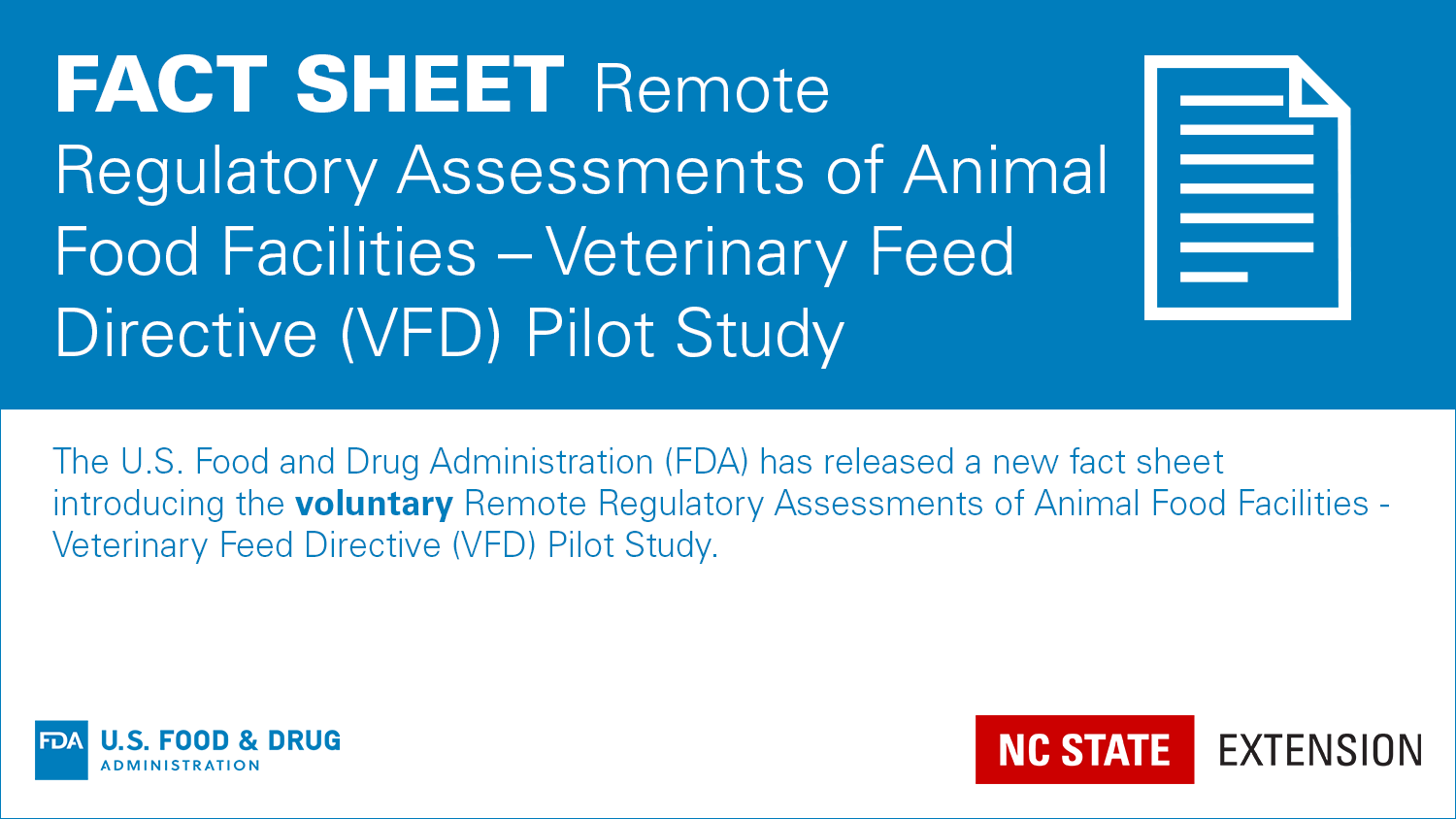Remote Regulatory Assessments of Animal Food Facilities – Veterinary Feed Directive (VFD) Pilot Study
go.ncsu.edu/readext?775979
en Español / em Português
El inglés es el idioma de control de esta página. En la medida en que haya algún conflicto entre la traducción al inglés y la traducción, el inglés prevalece.
Al hacer clic en el enlace de traducción se activa un servicio de traducción gratuito para convertir la página al español. Al igual que con cualquier traducción por Internet, la conversión no es sensible al contexto y puede que no traduzca el texto en su significado original. NC State Extension no garantiza la exactitud del texto traducido. Por favor, tenga en cuenta que algunas aplicaciones y/o servicios pueden no funcionar como se espera cuando se traducen.
Português
Inglês é o idioma de controle desta página. Na medida que haja algum conflito entre o texto original em Inglês e a tradução, o Inglês prevalece.
Ao clicar no link de tradução, um serviço gratuito de tradução será ativado para converter a página para o Português. Como em qualquer tradução pela internet, a conversão não é sensivel ao contexto e pode não ocorrer a tradução para o significado orginal. O serviço de Extensão da Carolina do Norte (NC State Extension) não garante a exatidão do texto traduzido. Por favor, observe que algumas funções ou serviços podem não funcionar como esperado após a tradução.
English
English is the controlling language of this page. To the extent there is any conflict between the English text and the translation, English controls.
Clicking on the translation link activates a free translation service to convert the page to Spanish. As with any Internet translation, the conversion is not context-sensitive and may not translate the text to its original meaning. NC State Extension does not guarantee the accuracy of the translated text. Please note that some applications and/or services may not function as expected when translated.
Collapse ▲The U.S. Food and Drug Administration (FDA) has released a new fact sheet introducing the Remote Regulatory Assessments of Animal Food Facilities – Veterinary Feed Directive (VFD) Pilot Study.
This new VFD pilot is similar to the other FDA Remote Regulatory Assessment (RRA) programs for human food and other FDA-regulated products.
The VFD RRA program is completely voluntary and facilities are not required to participate in the program.
What is a Remote Regulatory Assessment (RRA)?
With COVID-19 impacting nearly every aspect of life over the past year, the FDA has developed a remote regulatory assessment (RRA) program to keep FDA, state and facility personnel safe during the pandemic. They hope the RRA program will be useful in the future for increased efficiency, limiting the time an investigator would need to be on-site during an inspection.
The new RRA program will focus solely on Veterinary Feed Directive (VFD) compliance and associated records.
What is the RRA Pilot Study Process?
The FDA begins by sending a letter requesting voluntary participation in the RRA program. The facility can choose whether or not to participate in the program.
If the facility chooses to participate in the RRA program, they should select one person from the facility to work with the FDA and provide information. The FDA will work with the designated person from the facility to explain the RRA process.
Information requested by the FDA will be shared electronically and securely, and the review process will consist of an FDA review followed by an interview (call or video) between FDA staff and facility staff. The facility can choose to meet with the FDA to provide context about submitted records when they are submitted to the FDA.
After the review process, similar to the traditional inspection process, a facility will send their most responsible person or designee to meet with FDA staff for a close-out meeting. During this meeting, FDA will verbally address any concerns.
What Else Should I Know About the RRA Program?
Since the RRA program is completely voluntary, it is not considered an inspection. As such, the following forms will not be issued as a result of participation in the program:
- FDA 482: Notice of Inspection
- FDA 483: Inspectional Observations
This pilot program will be used to determine whether the FDA can expand the RRA program to other FDA animal food safety regulations.
Read the full FDA fact sheet for more information.
The RRA program isn’t an inspection, but we’re here to help you prepare for inspections. Read our inspection factsheet to learn how to be better prepared before, during and after an inspection.
How Animal Food Facilities Can Prepare for Regulatory Inspections
Though they can be a source of worry, the fact of the matter is that many animal food facilities often think about preparing for inspections as the inspectors walk through their doors. One of the reasons for this is because the “what if” questions can be large in number, and so facilities get frustrated with trying to come up with a plan. With this in mind, we asked some regulators what advice they have for facilities in order to be proactive and help make the process go more smoothly. This document presents a number of practices that are not required, but might be useful as facilities prepare for, are subjected to, and evaluate the results of inspections.
If you have questions about animal food safety, please contact Marissa Cohen.



